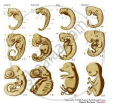Advertisements
Advertisements
Question
Mammals : _________ : : Amphibia : Fishes
Solution
Mammals : Reptiles : : Amphibia : Fishes
APPEARS IN
RELATED QUESTIONS
Differentiate between homology and analogy. Give one example of each.
Study the following statements:-
I. Wings of birds and wings of bats are homologous organs.
II. Wings of birds and wings of insects are modified forelimbs.
III. Wings of birds and wings of insects are analogous organs.
IV. Wings of birds and forelimbs of horse are homologous organs.
The correct statements are
(A) I and II
(B) II and III
(C) III and IV
(D) I and IV
With the help of any two suitable examples explain the effect of anthropogenic actions on organic evolution.
Find out from newspapers and popular science articles any new fossil discoveries or controversies about evolution.
Give the importance of fossil in support of organic evolution
The wings of a housefly and the wings of a sparrow are an example of :
(a) analogous organs
(b) vestigial organs
(c) respiratory organs
(d) homologous organs
Read the following statement and justify same in your own words with the help of suitable example.
There is evidences of fatal science among chordates.
Vestigial organ ______ present in human body is proof of evolution.
Observe the picture and answer the following questions.
A) Which evidence of evolution is shown in the picture?
B) What can be proven with this proof?
C) Give one more example of evidence of evolution
_______ is a connecting link between Annelida and Arthropoda.
Choose the correct option of the following question:
Wings of Insect and Birds are examples of :
Very short answer question.
What are homologous organs?
Very short answer question:
What is vestigeal organ?
Find an odd one out.
Find an odd one out.
Appendix : vestigial organ : : Peripatus : ____________
Give scientific reason.
Duck-billed platypus shows relationship with mammals.
Enlist the evidences of evolution.
Observe the following images and answer the questions.

- Which evolutionary evidences are indicated in the given picture?
- How are they formed?
- Which method is used to measure their age or their time?
Explain any five types of evidence that support the theory of evolution.
The degenerated and non-functional organs found in an organism are called ______.
Select vestigial organs from the following.
Homologous organs and vestigial organs are examples of ______ type of evidence in evolution.
Select the CORRECT match.
Why do all the gametes formed in human females have an X chromosome?
Evolutionary convergence is the development of:
The process of mating of individuals, which are more closing related than the average of the population to which they belong is called ______.
Which is not a vestigial organ in a man?
Organs having similar functions but different origin and development are known as:
The bones of forelimbs of whale, bat, cheetah and man are similar in structure, because ______.
What were the characteristics of life forms that had been fossilised?
Did aquatic life forms get fossilised? If, yes where do we come across such fossils?
What are we referring to? When we say 'simple organisms' or 'complex organisms'.
Give an example for convergent evolution and identify the features towards which they are converging.
You have studied the story of Pepper moths in England. Had the industries been removed, what impact could it have on the moth population? Discuss.
What is the function of the appendix of our digestive system?
Evolutionary convergence is the development of a ______.
